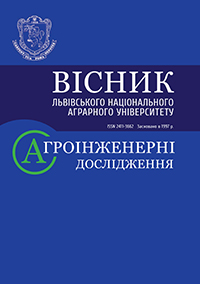THE CLASSICAL METHOD OF LINEAR CIRCUITS TRANSIENTS WITH POLYNOMIAL INPUTS
DOI:
https://doi.org/10.31734/agroengineering2018.01.140Keywords:
classical method, transient processes, harmonic function, calculation algorithm, Cauchy problemAbstract
The vast majority of objects are non-stationary, they vary in time under the influence of internal and external factors. For a formal description of nonstationary processes, a special mathematical apparatus, called differential equations, was developed. Different methods for calculating transient processes in linear circuits take into account the different number of expansion members (in multi-step methods in conjunction with interpolation formulas), which determines the accuracy of computations. When using these methods on a computer it is necessary to distinguish the rounding errors due to the limited number of significant digits in the computer; cut-off error (limitation) is a methodological error associated with the approximation of solutions to finite rows, instead of infinite, for example, Taylor series. Methods of solving the Cauchy problem are divided into one-to-one and multi-step. In one-step methods, finding the next point on the curve requires information about only one previous step (Euler's and Runge-Kutta's methods). In multi-step methods, finding the next point on the curve requires information from more than one of the previous points. From a mathematical point of view, the classical method for calculating transition processes in linear circles is the easiest among known methods for solving the Cauchy problem for a linear system of differential equations with constant coefficients. Analysis of the problem has shown that if, before the description of transient processes in linear electric circles, it is not the differential equations that are integral, then the mathematical formulation of the problem is simpler from the conceptual point of view.
In the article the variant of the classical method for calculating transient processes in linear stationary electric circles is considered, which allows to write down the systems of algebraic equations with unknown parameters of the solution of the problem directly on the basis of the system of integral equations of the process in a circle.
References
Ango A. Matematika dlya elektro- i radioinzhenerov. Moskva: Vyissh. shk., 1965. 658 s.
Bessonov L. A. Teoreticheskie osnovyi elektrotehniki: elektricheskie tsepi. Moskva: Gardariki, 2002. 536 s.
Blazhkevych B. I. Osnovy teorii liniinykh elektrychnykh kil. Kyiv: Vyshcha shk., 1964. 584 s.
Herman A. Matematychne modeliuvannia asynkhronnoho heneratora z vnutrishnoiu yemnisnoiu kompensatsiieiu. Visnyk Lvivskoho natsionalnoho ahrarnoho universytetu: ahroinzhenerni doslidzhennia. Lviv, 2017. № 21. S. 184–189.
Hrechyn D. P. Doslidzhennia elektromahnitnykh poliv u providnii feromahnitnii trubi. Visnyk NU “Lvivska politekhnika”. Elektroenerhetychni ta elektromekhanichni systemy. Lviv, 2003. № 487. S. 140–145.
Hrechyn D. P. Modeliuvannia nestatsionarnoho elektromahnitnoho polia u neskinchennii dvosharovii providnii feromahnitnii trubi. Visnyk NU “Lvivska politekhnika”. Elektroenerhetychni ta elektromekhanichni systemy. Lviv, 2009. № 654. S. 71–73.
Hrechyn D. P., Herman A. F., Drobot I. M. Kontynualna matematychna model elektromahnitnoho polia asynkhronnoi mashyny iz zubchatym feromahnitnym rotorom. Visnyk Lvivskoho natsionalnoho ahrarnoho universytetu: ahroinzhenerni doslidzhennia. 2016. № 20. S. 34–41.
Hrechyn D. P., Drobot I. M., Herman A. F., Dubik V. M. Vplyv rozmiriv paza rotora na velychynu puskovoho momentu korotkozamknenoho asynkhronnoho dvyhuna. Zbirnyk naukovykh prats Podilskoho derzhavnoho ahrarno-tekhnichnoho universytetu. Tekhnichni nauky. Kamianets-Podilskyi, 2016. № 24, ch. 2. S. 47–54.
Evdokimov F. E. Teoreticheskie osnovyi elektrotehniki. Moskva: Vyissh. shk., 1981. 488 s.
Perkhach V. S. Teoretychna elektrotekhnika: liniini kola. Kyiv: Vyshcha shk., 1992. 439 s.
Uayd D., Vudson G. Elektromehanicheskoe preobrazovanie energii. Leningrad: Energiya, 1964. 539 s.
Filts R. Rivnovazhnykove chyslennia: monohrafiia. Lviv: Lviv. derzh. in-t novitnikh tekhnolohii ta upravlinnia im. V. Chornovola, 2010. 184 s.
Filts R. V., Liabuk M. N. Operatornyi metod analizu perekhidnykh protsesiv v elektrychnykh kolakh: navch. posib. Lutsk, 2008. 200 s.
Chaban A. V. Pryntsyp Hamiltona-Ostrohradskoho v elektromekhanichnykh systemakh. Lviv: Vyd-vo Tarasa Soroky, 2015. 488 s.
Chaban A. V., Levoniuk V. R., Drobot I. M., Herman A. F. Matematychne modeliuvannia perekhidnykh protsesiv u linii Lekhera v stani nerobochoho khodu. Elektrotekhnika i elektromekhanika. 2016. № 3. S. 30–35.
Shimoni K. Teoreticheskaya elektrotehnika. Moskva: Mir, 1964. 785 s.
Hrechyn D. Modeling of non-stationary electromagnetic field in infinite two-layer conducting ferromagnetic plate. Proceedings of the XIII International symposium on theoretical electrical. Lviv, 2005. Р. 36–38.
Hrechyn D. P., Herman A. F., Drobot I. M. Continuum mathematical model of the electromagnetic field of a linear asynchronous machine. Motrol. Motoryzacia i energetyka rolnictwa. Lublin, 2016. Nо. 17. Р. 31–35.
Мayr O. Beitriige zur Theorie des statischen und des dynamischen Lichtbogens. Archiv fur Elektroteсhnik. Heft, 1943. N. 37. Р. 588–608.
Filc R., Stefaniak Z., Hreczyn D. Modelowanie matematyczne niestacjonarnego pola elektromagnetycznego w płycie ferromagnetycznej. Prace XXIII Międzynarodowej konferencji z podstaw elektrotechniki i teorii obwodуw IC. Gliwice, 2000.
Р. 67–72.


